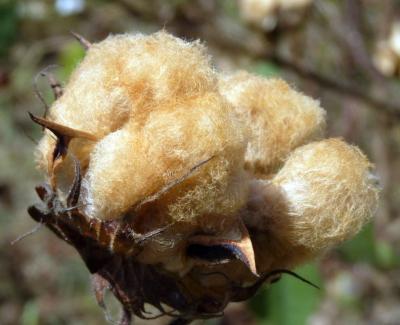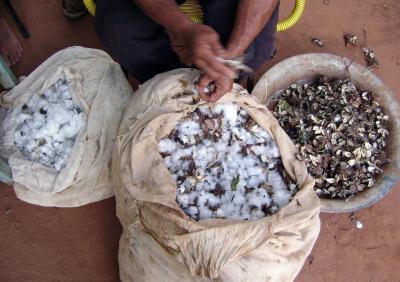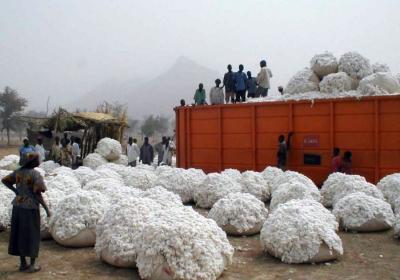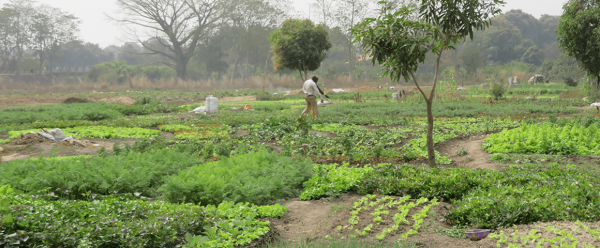Institutional news 12 December 2023
- Home
- Our activities, our impact
- Tropical value chains
- Cotton

Cotton
Cotton is a shrub from the family Malvaceae. It grows on every continent, as there are many varieties suited to a range of climates, and many ways of growing it. Cotton plants are cultivated for their fruits, known as “bolls”. Once ripe, the bolls split to reveal a small white ball: cotton. The raw product is know as seed cotton, which is ginned to separate the fibre from the seeds. The fibre is spun to make yarn and woven to make fabric. The seeds provide oil and presscake.
Cotton, white gold from the Americas
Cotton, Gossypium , is a shrub from the family Malvaceae, which includes hollyhocks, mallow, hibiscus, okra, and cocoa. The genus Gossypium includes 50 cotton species, four of which have been domesticated for the fibre produced by their seeds. Two species that originated in the Americas now account for most of the cotton produced worldwide: Gossypium hirsutum, from Mexico, which produces some 90%, and Gossypium barbadense, from Barbados, which produces the best fibre but only accounts for around 5% of the total. The other two species originated in the Old World: Gossypium herbaceum, from southern Africa, and Gossypium arboreum, from India, account for around 5% of global output. Their shorter, thicker fibres are generally used by local spinners and weavers.
Cotton plants flower as they grow, and are thus said to have a continuous growth cycle. This means that at any given time, a plant may bear buds, flowers and fruits, known as “bolls”, which contain the seeds. The bolls split to reveal a small white ball of fibre.
Fibre, a living cell
Cotton fibre is a living cell, with outer walls surrounding cytoplasm. The walls are made up of several layers of microscopic fibres: cellulose microfibrils.
Before the pod splits, the fibres dry out and die: the tube loses its contents and the walls become flattened and twisted. In its raw state, the fibre is an almost pure cellulose sheath with a fine coat of wax that makes it waterproof (or hydrophobic). Under a microscope, it looks like a long, thin corkscrew.
Cotton fibre is naturally either white or coloured. There are varieties that produce brown, khaki, yellow and greyish-green fibre. The American Indians commonly used coloured cottons, while in industrialized countries, the development of chemical dyes boosted demand for white fibre.
Cotton is grown on every continent
If cotton is grown on every continent, it is because there are many varieties suitable for a range of climates, and also many ways of growing it. With irrigation, cotton can grow in the desert, for instance in Arizona and Uzbekistan. Cotton plants need heat (25-35° for 150 days), a lot of sunshine, and water, particularly during flowering.
In many African countries, it is grown as a rainfed crop, ie without irrigation, and requires considerable labour. Cropping operations are done by hand or using draught animals, and the cotton is always picked by hand.
In the main producing countries, cotton is generally irrigated, and operations are entirely mechanized. The crop thus requires little in the way of labour and is given huge quantities of pesticides and fertilizer.
On a global scale, 55% of the area planted with cotton is irrigated, supplying three quarters of the world crop: 30% is irrigated in India, 43% in the United States and 75% in China.
Even the very first civilizations used cotton fibre to make textiles. Archeologists have found cotton fabric fragments dating back some 8000 years in the Indus Valley of Pakistan and more than 7200 years in Mexico. The art of making cotton fabrics began in India and spread throughout the Old World. As long ago as 445 BC, the Greek historian Herodotus wrote of India “there are trees growing wild that produce better, finer wool than sheep”. In the 7th century, the Arab conquests spread the use of cotton to North Africa and Europe. Trade between Europe and India really took off with the opening of the route to India by Vasco da Gama in 1497. With the invention of the Jacquard loom, cotton contributed to the Industrial Revolution in Europe. Progress was made in spinning and weaving, and cotton clothing, even very fine cotton, became universally accessible. It was the invention of the saw gin that heralded the boom in cotton growing in the United States. In the early 20th century, 90% of the world cotton trade was controlled by Europe, with raw cotton supplies primarily coming from the United States, India and Egypt. Cotton is now grown in some 100 countries on five continents.
From sowing to picking
Cotton is sown in rows. On non-mechanized farms, farmers dig small holes where they place the seeds. When a seed germinates, a seedling appears; this is known as emergence. The seedling then stops growing for a few days to allow the roots to become established and supply it with water. After a month, the seedling has four fully open leaves and is around 15 centimetres tall. At this point, the farmer pulls up all but the best two seedlings in each hole; this is known as “thinning”.
Around fifty days after germination, the first flowers become fruits, or bolls. The bolls ripen and then split, one by one, revealing the fibre inside. Each boll contains around thirty seeds, each of which is surrounded by very fine hairs: cotton fibre. This is why the picked product is called “seed cotton”. On average, it comprises 55% seeds, 40% fibre and 5% trash. From sowing to picking takes between 140 and 230 days, depending on the cotton variety.
Picking
Hand-picking is very labour-intensive. In West and Central Africa, for instance, whole families are involved, as the farms in the region are generally small and only grow cotton. Children, parents and grandparents pick the crop in successive rounds as the bolls split. A picker can harvest 50 to 80 kilos of seed cotton a day. Hand-picking results in clean fibre, with no undesirable crop waste.
In Brazil, on the other hand, where cotton is picked mechanically, farmers count the bolls in their fields. Once 80% of the bolls have split, they spray the field with a product known as ripener, which, as its name suggests, speeds up ripening. They then spray it with a defoliant that makes the leaves fall off so as to facilitate mechanical harvesting. Once 95% of the bolls have split, the crop is ready for picking, and the cotton pickers are brought out. In the United States and Europe, like in Brazil, mechanical pickers are used. A cotton picker can harvest 800 kilos of seed cotton an hour. Mechanical picking has the disadvantage of collecting bits of bolls, twigs and leaves at the same time as the seed cotton, and more subsequent cleaning is required than with hand-picked cotton.
Cotton has to cope with many enemies
Diseases caused by viruses, bacteria or fungi disrupt cotton plant growth or destroy the bolls. There are also insects that eat the leaves and bolls or attack the roots.
The damage caused is often substantial. It results in crop losses and deterioration of the fibre, which can no longer be used for spinning.
There are 1300 insect and animal species that feed on cotton, including almost 500 in Africa alone! The most common include:
the boll weevil (Anthonomus grandis), which caused a major cotton production crisis in the United States in the late 19th century. Thousands of dollars were spent to eradicate it in certain southern States.
the bollworm Diparopsis watersi, which as its name suggests, attacks the bolls. It is one of the most dangerous insects for cotton.
the aphid Aphis gossypii, which sucks the sap and weakens the plant. It also damages the fibre with its sugary excrement, known as honeydew. If honeydew contaminates the fibre in open bolls, it makes it sticky and thus difficult to spin. Sucking insects also carry viral diseases such “blue disease”.
From chemicals to integrated pest management
Chemicals were long seen as a universal solution to the problems posed by insects, but some insects have become resistant. Despite that, some countries still spray their cotton crops liberally, with up to 20 spraying rounds a year! Until recently, cotton growing accounted for 25% of global insecticide sales.
However, growers in many producing countries are now switching to "integrated" pest management, combining several techniques so as to cut pesticide use. This also accounts for the success of genetically modified cotton plants, which were developed for their resistance to bollworms. The best known and most widely grown GM cotton varieties produce a protein that kills bollworms, enabling farmers to cut their chemical insecticide use. In China, GM varieties have helped to revive the cotton sector, enabling a two-thirds reduction in insecticide use.
From raw cotton, through yarn, to fabric
After picking, the seed cotton is taken by truck to the ginning plant. It is cleaned by machines that remove any large impurities (leaves, twigs or bolls). It is then ginned, ie the fibre is separated from the seeds. The fibre is cleaned by machines that remove any smaller impurities. By the end of the line, the cotton fibre is clean. It is then compacted and compressed into 225-kilo bales. Modern ginning plants produce a bale a minute, or more than 1000 bales a day!
Before delivery to the customer, cotton bales are grouped together in batches of uniform quality. To this end, fibre quality has to be assessed; this is known as fibre classification. Ginning plants send samples from each bale produced to a classification laboratory. Classification specialists (called “classers”) estimate fibre length and grade with the naked eye. They judge it on three criteria: colour (yellow, cream or white), sheen, and trash (impurity) content. This is done by comparison with international standard cottons. The world cotton price has always been based on these international standard cottons, but this method is gradually being supplanted by more complex qualitative and intrinsic criteria that can be measured by automatic integrated measurement systems (IMS).
Spinning consists in making a linear textile from clumps of cotton fibre delivered as bales of various origins. The tangled mass of cotton fibre is spun to make a highly structured yarn. The fibre is first prepared, ie cleaned, untangled and separated, followed by several other, successive operations:
- carding: the fibres are separated from mineral or organic non-fibre elements and bunched together in long slivers.
- drawing out: the fibres in each sliver are combed, and several slivers are combined to make a rope, which is still relatively fragile.
- spinning proper: yarn is obtained by drawing out the rope and twisting its multitude of fibres. The fact of twisting the fibres into a spiral and the wax they contain give the yarn its cohesion and strength. How can such long, strong yarn be made from such short fibres? There are between 100 and 250 cotton fibres from 1 to 3 centimetres long in the thickness of a cotton thread. It takes just 20 grams of fibre to make a kilometre of fine yarn.
- weaving and knitting: weaving produces stronger fabrics. Knitting gives stretchier, softer and breathable fabrics (t-shirts, socks). Industrial looms can produce 500 metres of fabric a day.
- Special treatments can make cotton look or feel different (satiny), or render it stain-repellent, antibacterial, anti-UV, creaseproof, waterproof, fire resistant, etc. This can also be done by blending cotton with synthetic fibres with the appropriate properties.
Fabric and knits may also be specially treated, depending on their end use:
singeing: the fabric is superficially burnt to remove any small fibres that may be sticking out and stop it from pilling.
napping: conversely, it can be scraped for a “peach skin” effect.
boiling off and bleaching: the fabric is placed in a bath of water and caustic soda, which removes the natural wax, swells the fibres and makes the fabric absorbent. A second bath of hydrogen peroxide bleachnes the fabric so it will “take” dye better.
mercerizing: yarn or fabric can be soaked in an alkaline bath. This makes the fibres swell and gives them a sheen. It also increases their dye retention capacity. Mercerized fabrics are more compact and stronger than non-mercerized ones.
dyeing (soaking the fabric in a dye bath) or printing (stamping a monochrome or multicoloured pattern on the fabric), to make fabric more attractive and decorative. Yarn may be dyed directly, before weaving or knitting, to produce special effects (stripes, checks, etc).
The main uses of cotton yarn are ready-made clothing (60%), furnishings (35%), and work garments (5%). Cotton is also used in medical and hygiene products, notably cotton wool, compresses, gauze bandages, sanitary tampons, cotton buds, etc. It is the variety Gossypium herbaceum that is most used to make cotton wool, as it has short, thick fibres.
Madras, from the famous city in India, is a fabric with a silk warp and cotton weft, in bright colours, used to make scarves, squares, etc.
Muslin means “from Mossul”, a city now in Iraq. A very fine plain, striped, checked or embroidered fabric.
Calico from Calicut, an Indian city now called Kozhikode, which was Vasco da Gama’s first stop in India in 1498.
Chintz, a Hindi word, referring to a printed cotton used for furnishings.
Damask, a white fabric with a woven, textured pattern.
Fustian, a thick woven drill or twill, made from a linen or wool and cotton blend.
Twill, cotton fabric with an oblique weft (like denim).
Siamoise, a linen and cotton blend, striped, checked, sometimes with wool brocade.
Canvas or cloth, initially a wool, linen or cotton woven fabric (ticking, calico, percale, cretonne, etc), the simplest of all fabrics and the most commonly used. Waxed cloth is coated to make it waterproof. Métis has a cotton warp and linen weft.
Gauze is a light, see-through, openwork fabric that takes its name from the city of Gaza, obtained by crossing straight threads and twisted threads to stop the threads slipping; by extension, any openwork taffeta fabric.baceum that is most used to make cotton wool, as it has short, thick fibres.
Seeds with many uses
Every part of a cottonseed has either an industrial or a food use.
The fuzz around the seeds (known as linter) comprises short cellulose fibres that are used to make felt, stuffing for mattresses, furniture and car seats, compresses, gauze, cotton wool, wicks, yarn for rug-making, etc. Food derivatives can also be extracted (dietary fibre, thickeners, excipients, etc). There is an international market for linter, by virtue of its many uses.
The hull of the seeds can be burnt to generate energy for oil mills. It can also be used as an animal feed or to make synthetic derivatives for the chemicals industry.
The seed kernel is very rich in oil and protein, but it contains a toxic pigment, gossypol, which is removed by traditional and industrial processes. Pressing the kernels produces an excellent edible oil, which can also be used to make soap. There are now naturally glandless cotton varieties (without the glands that produce gossypol), which are grown on a large scale in some countries. Cottonseed oil is the sixth most widely consumed oil worldwide. It is high quality, rich in polyunsaturated fatty acids (including vitamin E), and cholesterol-free. However, it is not as good for cooking as the other main oils. In certain cotton-growing countries (Mali, Chad, Burkina Faso, Togo, etc), it accounts for a major share of edible oil consumption.
The paste left after oil extraction is made into cake that is fed to ruminants (cows and sheep, the only animals that can detoxify gossypol during digestion). Cottonseed presscake has a high protein content (up to 49% over dry matter), three to six times higher that that of cereals and up to 20 times higher than some fodder crops. It is also the plant-based feed with the most phosphorus. Presscake can also be used for other agricultural purposes, for instance as a fertilizer or a mushroom growth substrate. There is an international market for presscake, and most producing countries export it.
Hemp was used to make clothes as long ago as 600 BC in China. Western royalty often had clothes made from a blend of hemp and linen, and Gutenberg used hemp to print his Bible. In the 20th century, it was used to make military uniforms in both World Wars. It was also used for a long time to make banknotes (before being replaced by ramie, or Chinese nettle), and sailcloth. It is still used to make cord and rope. There are several subspecies of hemp, one of which, Indian hemp, more commonly known as cannabis, is grown for its psychotropic properties.
Jute, which is from the same family as cotton, is grown in the tropics for its fibre. It is not really suitable for clothing textiles, and is primarily used to make sackcloth. It can also be used to make rope.
Kapok comes from the hulls of the seeds of a tropical tree. The tree (Ceiba pentendra ) was symbolic in Mayan mythology. Its fibre is used to make mattresses, and the fact that it is both waterproof and light means that it is also used to make lifejackets. The fibre is both very smooth and waxless, and cannot be spun.
Flax is a herbaceous plant with fibrous stems and attractive blue flowers. It grows in temperate and subtropical areas of the northern hemisphere. Flax fibre is used to make rope, fabric (linen), and insulating materials for the building trade.
Nettles were used to make fabric in the past. European nettles were abandoned, as their fibres are too short and unsuitable for industrial use, but fabrics are still made from a tropical nettle: ramie. Nettles have also been used to make paper.
Ramie, or Chinese nettle, is a textile plant whose fibres are now used to make cigarette paper, banknotes, sewing thread, special fabrics, velvet, fishing nets, etc. It has been used for six thousand years, making it one of the oldest textile plants in the world. Ramie is not only grown for its textile fibres, but also as an ornamental plant in Asia, because of its heart-shaped leaves. Ramie is now mainly grown in China, Brazil, the Philippines, India, South Korea and Thailand.
Sisal is extracted from the leaves of Agave sisalana, a plant from the family Agavaceae that originated in eastern Mexico. Its fibre is very strong, and is used to make rope, coarse fabrics and carpets. Until the 1970s, it was often used to make the string that European farmers used to tie up hay bales, but since the advent of hay presses, it has been replaced by polyethylene string.
































.jpg)







